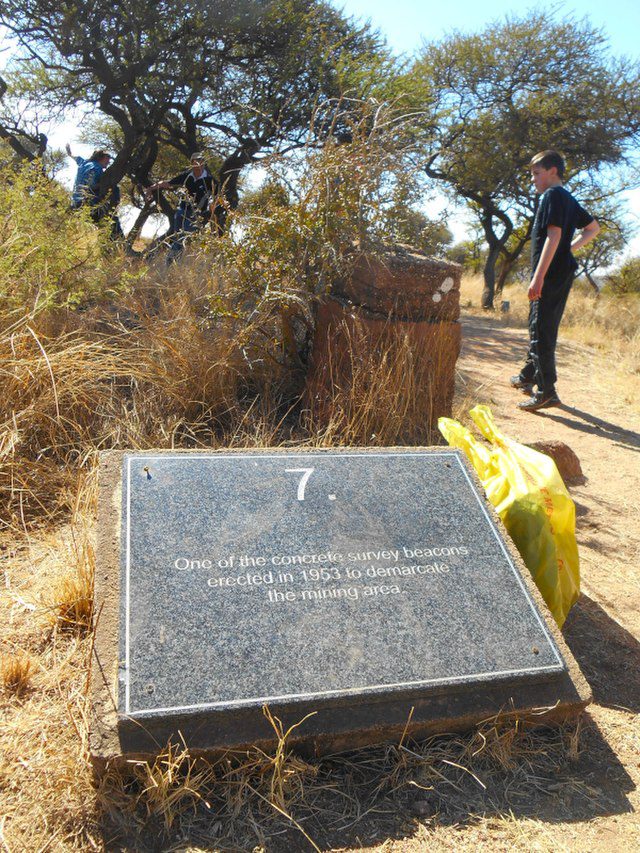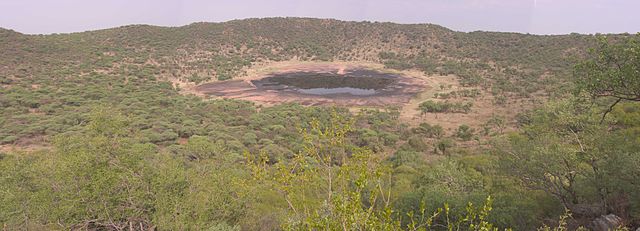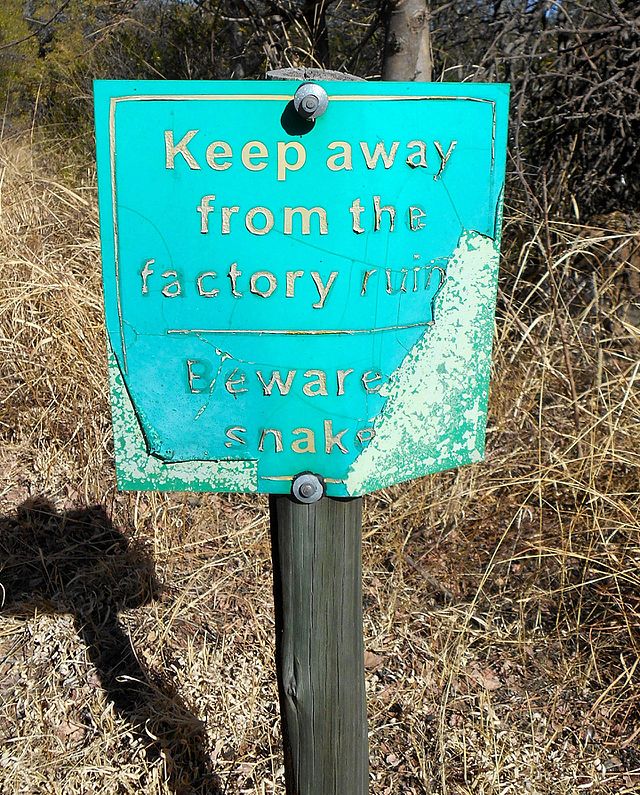
Tswaing Crater plaque no. 7. Photo by Ossewa – Wikimedia Commons
Top 10 Remarquable Facts about Tswaing Crater
Some 220 000 years ago a meteorite half a soccer field in diameter, traveling at 4 000 kilometers per hour, hit what is now the Gauteng province of South Africa, exploding with the impact of 100 atomic bombs.
The result was the Tswaing Meteorite Crater, just over one kilometer in diameter, now a spectacular natural wonder with a salt lake at its heart.
1. Tswaing is an impact crater in South Africa

Tswaing crater. Photo by Martin Tuchscherer – Wikimedia Commons
Tswaing is an impact crater in South Africa that is accompanied by a museum. It is situated 40 km to the northwest of Pretoria.
Tswaing Crater was created from a meteorite hitting the earth 220 000 years ago.
Some 40 kilometers north of Pretoria, the site attracts 14 000 visitors a year, mostly Gautengers, who come to marvel at the crater, nestled within a 60m-high forested ring.
2. The crater is one of around 170 impact craters in the world

Tswaing crater north of Pretoria, South Africa. Photo by Rotational – Wikimedia Commons
The crater is one of around 170 impact craters in the world and one of four known impact craters in South Africa. What’s special about Tswaing is that it is one of the best-preserved meteorite craters in the world, and secondly, that it’s very accessible – you can walk down into the crater, taking in its quiet beauty.
3. The immediate area is up to three kilometers around the crater

Tswaing, Salt Pan Crater. Meteorite Crater 39 km north of Pretoria. Photo by Hp.Baumeler – Wikimedia Commons
At the point of impact, the immediate area up to three kilometers around the crater, all life forms and rock as well as the meteorite itself would have vaporized. A broader area of 1 000 square kilometers would have been flattened. A gigantic air blast of up to 1 000 kilometers per hour would have added to the destruction.
These days the whole site is covered in dense bushveld and walking along the trail on the rim, you’ll look down into this marvelous phenomenon, with the small 100-meter diameter lake at its center.
4. The lake is filled with rain water and a spring

Tswaing crater montage. Cratère de Tswaing. Photo by Myiu – Wikimedia Commons
The lake is filled with rainwater and a spring. It used to contain high concentrations of salt and soda ash, which were mined for 44 years until 1956. The salt content has dropped, making it no longer viable to mine.
5. The crater is contained within a 2, 000ha nature reserve

Tswaing crater. A memorial in honor of Eugene Merle Shoemaker at the Tswaing impact crater in Tswane, South Africa. Photo by NJR ZA – Wikimedia Commons
Today the crater is contained within a 2 000ha nature reserve focused on the preservation of the natural and cultural heritage. The reserve consists of several habitats: wetland, savannah, forest, riverine bush, and its ecosystem centered around the salt lake, which is 13 times saltier than the Dead Sea, says Julia Barnes, deputy director of Ditsong: Tswaing Meteorite Crater.
The Soutpanspruit, a stream running east of the crater, feeds an extensive wetland system, with a mini delta harboring numerous streams and islands. Up to 250 bird species have been recorded, among them the African hawk eagle, the river warbler, bee-eaters, and kingfishers. Game is abundant: kudu, impala, zebra, warthog, mongoose, snakes, and leguaans or monitor lizards are to be found.
Up to 480 plant species have been recorded in two rare habitats, says Barnes.
6. The Tswaing Meteorite Crater management team invited community participation

Tswaing crater, north of Pretoria. It is about 1.1 km in diameter and was formed as the result of a meteorite impact some 200 000 years ago. Photo by brianvds – Wikimedia Commons
From the onset, the Tswaing Meteorite Crater management team invited community participation in its planning and development. Local communities have already benefited through job creation, skills training, environmental education, income-generating projects, and tourism.
7. Tswaing was originally thought to be a volcano

Tswaing signs. Info sign at Tswaing Crater, near Pretoria. Photo by Ossewa – Wikimedia Commons
Tswaing was originally thought to be a volcano, but in 1989 boreholes were drilled into the crater floor, hitting solid granite at 200m. Analysis of quartz grains showed that there were shatter cones and recrystallized glass fragments, typical of an impact, confirming its origins as the remains of the meteorite impact.
Also revealed were the climatic conditions going back 200 000 years. Unlike the present climate of sub-tropical and dry-humid conditions, in the past, there were alternating dry and wet periods, and at one point the site was a forest of yellowwood trees.
8. The name Tswaing means “place of salt” in Tswana

Tswaing salt works ruins. The lake at the Tswaing Crater was commercially exploited for salt and soda ash by by the company SA Alkali Ltd between 1922 and 1956. The ruins of the reduction works as well as some residences occupied by reduction workers can still be seen around the crater. Photo by Ossewa – Wikimedia Commons
The name Tswaing means “place of salt” in Tswana. The first visitors to the site arrived during Middle Stone Age times, about 150 000 to 30 000 years ago. Small nomadic groups came to Tswaing to hunt game, gather edible and medicinal plants, and collect salt.
Around 800 years ago, the Iron Age people came to visit. Their artifacts, such as decorated clay pots, have been found on the crater floor, indicating the presence of early Sotho or Tswana peoples. Their main reason for visiting was to collect salt, used for preserving and flavoring food, as well as for trading.
People subsequently settled in the area, farming cattle and crops, and collecting salt for domestic use.
When colonists reached the area they named it Zoutpan (Afrikaans, meaning “salt pan”), and settled, farming in the area.
In 1912 a soda mine was established in the crater and operated until 1956. After several grazing research projects in the area, in 1993 the department of agriculture took over a portion of the farm Zoutpan and developed it into an ecotourism destination for environmental education, recreation, and research.
These days various festivals are held at the site, the most popular being a music fest held in March. Accommodation is available in the form of four dormitory huts, sleeping 16 people each. The site is available for weddings and special occasions.
Guides are available for tours of the site, which is open from 7.30 am to 4 pm daily.
Local communities see the site as having religious importance. Sangomas, or diviners, are trained here at night. There is a belief that a snake lurks in the lake, says Barnes.
9. Another impact crater can be found about 120 kilometers southwest of Johannesburg

South Africa – Gauteng – Tswaing. Der Krater von Tswaing. Photo by Genet – Wikimedia Commons
Another impact crater can be found about 120 kilometers southwest of Johannesburg in the neighboring Free State province. The 250-300-kilometre wide Vredefort impact crater – formed by an asteroid some 10 kilometers in diameter hitting the earth – is located. Known as the Vredefort Dome, it dates back two billion years.
This crater is not as clearly identifiable as Tswaing as it covers a much larger area, but its northern edges reach southern Johannesburg.
10. Gold was discovered in Johannesburg in 1886

Tswaing crater north of Pretoria, South Africa. Photo by Rotational – Wikimedia Commons
The significance of the Vredefort Dome is that when the asteroid hit the earth, the gold-bearing rocks of the Witwatersrand, which were deposited some 800 million years before the Vredefort impact, were downfaulted and covered with impact debris, being thus protected and preserved from erosion over the subsequent aeons.
That gold was discovered in Johannesburg in 1886, and decades later is still being mined. One such operation extends to almost four kilometers below the surface – it is TauTona in Gauteng, the world’s deepest mine.
Planning a trip to Paris ? Get ready !
These are Amazon’s best-selling travel products that you may need for coming to Paris.
Bookstore
- The best travel book : Rick Steves – Paris 2023 – Learn more here
- Fodor’s Paris 2024 – Learn more here
Travel Gear
- Venture Pal Lightweight Backpack – Learn more here
- Samsonite Winfield 2 28″ Luggage – Learn more here
- Swig Savvy’s Stainless Steel Insulated Water Bottle – Learn more here
Check Amazon’s best-seller list for the most popular travel accessories. We sometimes read this list just to find out what new travel products people are buying.









